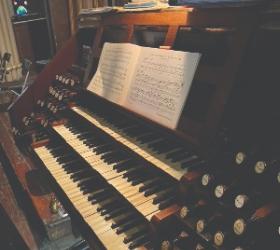
Kegg Pipe Organ Builders,
Hartville, Ohio
Christ Episcopal Church,
Eureka, California
It has often been stated that the most important stop of an organ is the room in which it is heard. True, but unremarkable. When a church actually takes to heart every suggestion of its acoustician and organbuilder and makes the needed improvements, that is remarkable indeed! Christ Episcopal Church in Eureka, California is such a church.
Sound-absorbing surfaces abounded at Christ Church. Carpeted floors, comfortably upholstered pews, and acres of Celotex on the ceiling and organ chambers offered dismal prospects for a successful new organ. The choir sat in pews on risers on one side of the chancel, with the organ console on the opposite side facing them. High above the altar, three lancets of stained glass let in so much light that the entire sanctuary area nearly disappeared in the glare.
Working with acoustician Ewart “Red” Wetherill, we established several imperatives. First, carpeting in the chancel needed to be replaced with a sound-reflective material of some kind. Second, absorptive material on the ceiling needed to be removed or covered, at least over the chancel area, but preferably throughout the entire nave. Third, at least part of the organ needed to speak on the main axis of the building. Lastly, any chamber spaces used needed to be covered in double-layer drywall.
In the end, the church made ALL the recommended improvements and the visual and acoustical result is stunning! The center tower and two flats of the new façade now give the three lancet windows a base, while the tall towers flanking the windows continue the lancet theme, stepping down away from the center. The semi-circle within a triangle motif at the tops of the towers comes directly from the trusses supporting the roof of the church. The beautiful wood altar, which had been nearly invisible in the old configuration, now sits in the middle of the chancel in a large circle inlaid in the new tile floor. Against the backdrop of the new organ case it is now very clearly the focal point of the front of the church. The choir now sits behind it in the optimum location for support from the organ, with the base of the case acting as a sort of acoustical shell projecting their sound. The altar and organ console are on wheels, and the choir chairs and chancel furniture are easily movable, creating a very flexible space without the appearance of a multipurpose room.
Because the Christ Church organ plays such an integral and varied role in the musical life of the community in addition to accompanying the Episcopal liturgy, we chose not to pattern its tonal scheme on any one particular musical period or style. But instead of the eclectic grab-bag that tries to cover all the bases, this organ speaks its own musical language with integrity and authority. And that language is decidedly American, though it converses fluently with most of Western Europe.
At its core, the instrument is a carefully developed two-manual that could function perfectly well with no borrowing at all. We then drew on our experience with unit organs to give the organist maximum flexibility in accessing those resources. The three-manual console and what appears to be a bevy of pernicious borrowing must always be viewed within that context.
Keeping the organ footprint small was a high priority. Projecting out less than 48 inches from the east wall, the front case houses the unenclosed Great chorus including the 16′ Violone, the full-length 16′ Trombone, the Pedal 16′ Subbass and generous walkboards for tuning access. The remainder of the organ is located in free-standing enclosures in the existing organ chambers. With the new double thickness of drywall on the chamber walls and the sloped ceilings of the swell boxes, organ sound now fills the church with very little effort. Building from the “Anglican mist” of the Flute Celeste to the thrilling satisfaction of full organ, each nearly imperceptible step along the way weaves an aural tapestry rich in color and texture.
An often unsung benefit of commissioning an organ from a relatively small company like ours is the relationship that develops between the organbuilding crew and a client congregation. Director of music Douglas Moorehead and his wife Carol (who surely is on the fast-track for sainthood), choir director Betty Burton, interim priest-in-charge Fr. Leo Joseph, parishioners Earl Morgan, John Patton, Leann Thoresen, Faye Judy and many others became like family to us and will stay in our hearts for a very long time. We invite you to visit them and their new Kegg organ.
—Fredrick Bahr, tonal director
Kegg Pipe Organ Builders
www.keggorgan.com
Kegg Pipe Organ Builders
Fredrick Bahr
Philip Brown
Michael Carden
Joyce Harper
Charles Kegg
Philip Laakso
Tom Mireau
Bruce Schutrum
GREAT Manual I
12 stops, 15 ranks, 903 pipes
16′ Violone 73 pipes
8′ Principal 61 pipes
8′ Violone (ext)
8′ Rohrflute* 61 pipes
8′ Harmonic Flute* 49 pipes
1–12 from Rohrflute
8′ Flauto Dolce* 61 pipes
8′ Flute Celeste* TC 49 pipes
4′ Octave 61 pipes
4′ Koppelflute* 61 pipes
22⁄3′ Twelfth 61 pipes
2′ Super Octave 61 pipes
11⁄3′ Mixture IV 244 pipes
8′ Trumpet (Pedal)
8′ Clarinet* 61 pipes
Tremulant
Chimes Existing bells, new action
Great Unison Off–Great 4
Zimbelstern 5 handbells
* Enclosed
SWELL Manual II
11 stops, 14 ranks, 902 pipes
16′ Gedeckt 73 pipes
8′ Diapason 61 pipes
8′ Gedeckt (ext)
8′ Salicional 61 pipes
8′ Voix Celeste 61 pipes
4′ Octave 61 pipes
4′ Nachthorn 73 pipes
22⁄3′ Nazard 61 pipes
2′ Flute (ext Nachthorn)
13⁄5′ Tierce 61 pipes
2′ Mixture IV 244 pipes
1′ Scharf IV From Mixture,
cancels Mixture when drawn
16′ Bassoon 73 pipes
8′ Trompette 73 pipes
8′ Oboe (ext)
8′ Vox Humana (console preparation)
4′ Clairon (ext)
Tremulant
Swell 16–Swell Unison Off– Swell 4
SOLO Manual III
8′ Solo Diapason III (Gt and Ped)
8′ Harmonic Flute (Gt)
8′ Salicional (Sw)
8′ Voix Celeste (Sw)
8′ Flute Celestes II (Gt)
Cornet V (Sw)
8′ State Trumpet (console preparation)
8′ Trumpet (Ped)
8′ Trompette (Sw)
8′ Oboe (Sw)
8′ Clarinet (Gt)
Tremulant
Chimes
Solo 16–Solo Unison Off–Solo 4
ANTIPHONAL Floating
Prepared in console only
8′ Principal 61 pipes
8′ Bourdon 85 pipes
8′ Dulciana 61 pipes
4′ Octave 61 pipes
4′ Flute (ext)
2′ Piccolo (ext)
Tremulant
8′ State Trumpet 61 pipes
flared bells, polished brass
Antiphonal to Great
Antiphonal to Swell
Antiphonal to Choir
Antiphonal to Pedal
PEDAL
3 stops, 3 ranks, 173 pipes
32′ Bourdon (ext, 1–12 generators)
32′ Resultant (derived)
16′ Open Wood 12 existing pipes,
44 new pipes
16′ Subbass 44 pipes
16′ Violone (Gt)
16′ Gedeckt (Sw)
8′ Octave (ext)
8′ Subbass (ext)
8′ Violone (Gt)
8′ Gedeckt (Sw)
4′ Super Octave (ext)
4′ Cantus Flute (Gt)
32′ Harmonics (derived)
16′ Trombone 73 pipes
16′ Bassoon (Sw)
8′ Trumpet (ext)
4′ Clarion (ext)
4′ Clarinet (Gt)
Tonal resources
26 stops, 32 ranks, 1978 pipes
Inter-manual couplers
Great to Pedal 8, 4
Swell to Pedal 8, 4
Solo to Pedal 8, 4
Swell to Great 16, 8, 4
Solo to Great 8
Swell to Solo 8
Great to Solo 8




